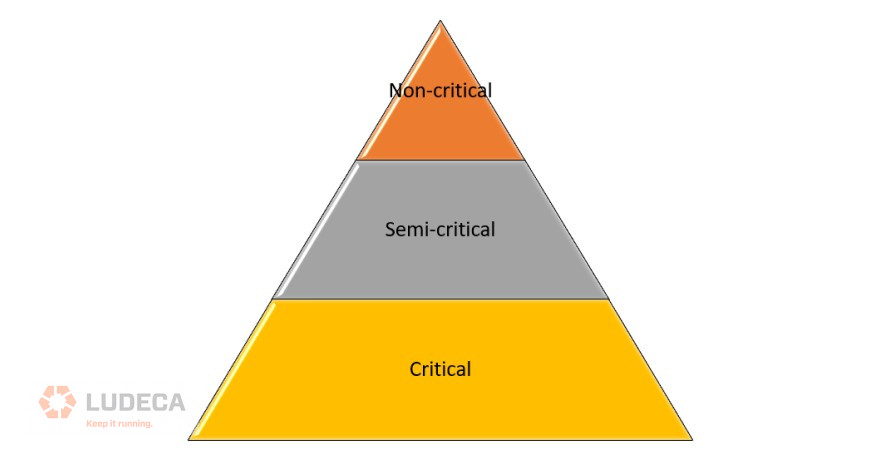In the first installment of this series, Optimizing an Effective Oil Analysis Program for Critical Assets – Why Focus on Critical Assets? Part 1, we focused on the reason for monitoring critical assets while also diving into the other types of assets. For this second installment, we will focus some more on actually developing an oil analysis program and some things you need to know.
By establishing a matrix of your critical, semi-critical, and non-critical assets, it becomes easier to allocate the required amount of resources to the monitoring of these assets. These assets can be ranked in a tier system where the non-critical assets are the first tier, semi-critical are the second, and critical are the third. Ideally, resource allocation to these should resemble the diagram below.

As seen above, the critical assets would require the most amount of time and resources. This helps us when developing an oil analysis program as we can determine the frequency of sampling and types of tests.
Used oil analysis programs will differ depending on the types of industry, equipment, and environmental conditions. For instance, it may be challenging to get oil samples from mobile equipment (such as an excavator, if they are on a customer’s site) compared to obtaining a sample from a stationary piece of equipment in a manufacturing plant.
Basic tests
When performing oil analysis, there are basic tests that transcend most oil types. These include; Viscosity, TAN/TBN, Spectroscopy (additives, wear metals, contaminants), Presence of water. These tests can give a preliminary indication of whether anything is occurring in the machine such as wear, if contaminants are getting in, or if there is a depletion of additives. They can guide us to the basic health of the oil and can be likened to having regular blood tests run by your doctor where they check for the level of red blood cells, white blood cells, and a couple of other values.
These basic tests should be done monthly for critical pieces of equipment as we need to develop trends which can aid us in the early identification of anything that may be of concern.
For semi-critical pieces of equipment, these tests can be carried out every quarter or at ¾ of the expected oil life of that equipment. For example, if the oil is changed every 500 hours, it would be a good idea to sample the oil at approximately 375 hours.
For non-critical pieces of equipment, these tests can be performed semiannually or about 1 week away from the planned date of oil change for the equipment. This ensures that the health of the asset is documented to allow trending to occur should something arise in the future. The cost of replacing the equipment should also be considered when determining the frequency of sampling. This can possibly move the asset from being non-critical to semi-critical.

Advanced tests
While the basic tests can help operators gauge the health of the asset, sometimes special advanced tests are also needed to better understand what’s happening inside the equipment. This is especially true for critical pieces of equipment as a greater insight into certain parameters can help prevent failures. However, these advanced tests vary by equipment / oil type.
For turbine oils (which are one of the most popular critical assets), there are quite a few advanced tests. This type of oil is usually subjected to extreme temperatures and conditions. As such, one of its main failure modes is oxidation (although others do exist). Therefore, some of the advanced tests for these turbine oils include; MPC (Membrane Match Colorimetry), RULER (Remaining Useful Life Evaluation Routine), FTIR (Fourier Transform Infrared) and RPVOT (Rotating Pressure Vessel Oxidation test – although this one does not give much repeatable results, it is still considered an industry standard). Typically, these tests may be carried out quarterly or semi-annually for critical pieces of equipment depending on what the user is trying to trend or monitor.
For gear oils, one may want to focus on the foam, water separability and wear tests as these have more impact on charting the health of these components. For critical gearboxes, if the oil has a high tendency to foam, this can lead to micro pitting and damage of the gears which in turn can cause the system to come to a standstill. These tests can be done quarterly for critical equipment and may only become necessary for semi-critical or non-critical equipment if an issue is being investigated. In these cases, there may be a root cause investigation underway to determine the cause of additional / unwarranted wear in these semi-critical or non-critical gearboxes.
When developing an oil analysis program, it is essential to categorize your assets to help determine the frequency and type of tests to be conducted. In this article, we focused on a simple three tier approach, but this can be more detailed and involved more tiers, it all depends on the organization in which we’re trying to implement the oil analysis program.
Stay tuned for the last instalment of this article where we explore the benefits of an optimized oil analysis program.
Thank you Sanya Mathura with Strategic Reliability Solutions Ltd for sharing this informative and educational article with us!
Do we really need Oil Analysis if We’re Performing other CM Techniques? – Part 1
Filed under:
Lubrication by Diana Pereda
